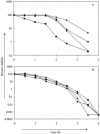Induction of oxidative stress by high hydrostatic pressure in Escherichia coli
- PMID: 15870304
- PMCID: PMC1087522
- DOI: 10.1128/AEM.71.5.2226-2231.2005
Induction of oxidative stress by high hydrostatic pressure in Escherichia coli
Abstract
Using leaderless alkaline phosphatase as a probe, it was demonstrated that pressure treatment induces endogenous intracellular oxidative stress in Escherichia coli MG1655. In stationary-phase cells, this oxidative stress increased with the applied pressure at least up to 400 MPa, which is well beyond the pressure at which the cells started to become inactivated (200 MPa). In exponential-phase cells, in contrast, oxidative stress increased with pressure treatment up to 150 MPa and then decreased again, together with the cell counts. Anaerobic incubation after pressure treatment significantly supported the recovery of MG1655, while mutants with increased intrinsic sensitivity toward oxidative stress (katE, katF, oxyR, sodAB, and soxS) were found to be more pressure sensitive than wild-type MG1655. Furthermore, mild pressure treatment strongly sensitized E. coli toward t-butylhydroperoxide and the superoxide generator plumbagin. Finally, previously described pressure-resistant mutants of E. coli MG1655 displayed enhanced resistance toward plumbagin. In one of these mutants, the induction of endogenous oxidative stress upon high hydrostatic pressure treatment was also investigated and found to be much lower than in MG1655. These results suggest that, at least under some conditions, the inactivation of E. coli by high hydrostatic pressure treatment is the consequence of a suicide mechanism involving the induction of an endogenous oxidative burst.
Figures






References
-
- Aertsen, A., and C. W. Michiels. 2004. Stress and how bacteria cope with death and survival. Crit. Rev. Microbiol. 30:263-273. - PubMed
-
- Alpas, H., N. Kalchayanand, F. Bozoglu, and B. Ray. 2000. Interactions of high hydrostatic pressure, pressurization temperature and pH on death and injury of pressure-resistant and pressure-sensitive strains of foodborne pathogens. Int. J. Food Microbiol. 60:33-42. - PubMed
Publication types
MeSH terms
LinkOut - more resources
Full Text Sources

